Stop Guessing! How Much Should I Feed My Cat? Vet-Approved Chart 😺
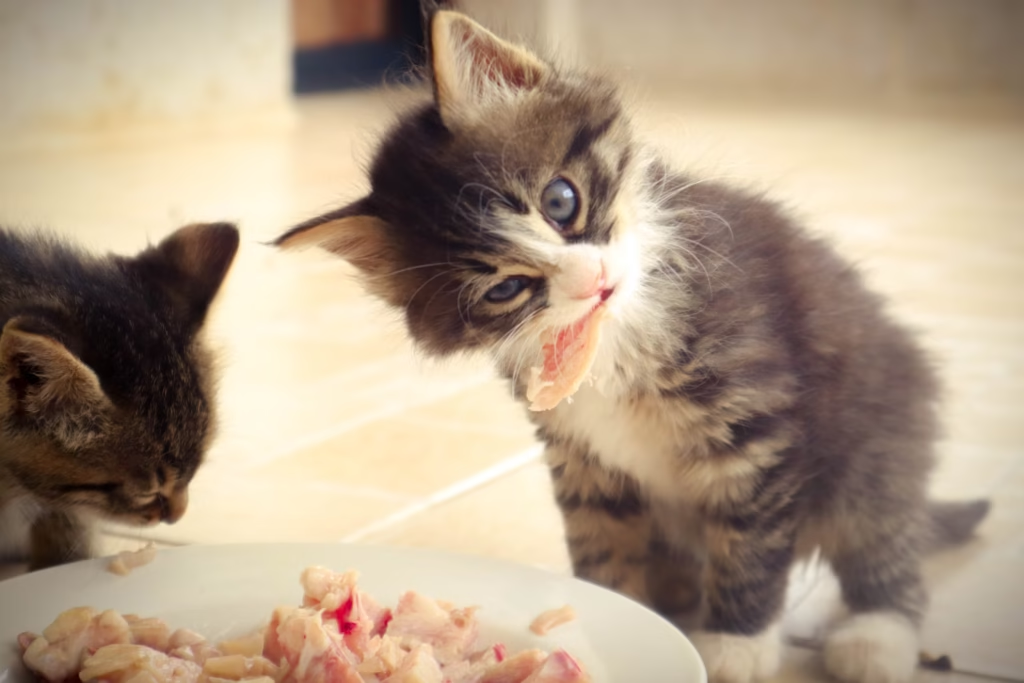
Feeding your feline friend can feel like solving a puzzle with missing pieces. 🧩 Too much food, and your cat might turn into a fluffy couch potato. Too little, and you’re left with a hangry kitty giving you the stink eye. 😾 If you’ve ever wondered, “How much should I feed my cat?” or “How often should I feed my cat?” you’re not alone. These are some of the most common questions cat parents ask, and we’re here to clear the confusion with a vet-approved feeding chart and actionable tips to keep your kitty purring with joy. 🐾
In this ultra-detailed guide, we’ll dive deep into the art and science of feeding your cat just right. Backed by veterinary expertise, we’ll explore portion sizes, feeding schedules, and pro tips to ensure your cat’s diet supports their health and happiness. Whether you’re a new cat parent or a seasoned pro, this article is packed with everything you need to stop guessing and start feeding with confidence. Let’s get started! 😸
Why Getting Cat Feeding Right Matters 🐱
Cats are obligate carnivores, which means their bodies are wired to thrive on a diet rich in animal-based proteins. Unlike dogs or humans, cats have unique nutritional needs that require careful attention. Feeding them the right amount of food isn’t just about keeping their bellies full—it’s about supporting their energy levels, weight, coat health, and even their longevity. 💪
Overfeeding can lead to obesity, diabetes, or joint issues, while underfeeding can cause malnutrition or behavioral problems. According to the American Veterinary Medical Association (AVMA), nearly 60% of cats in the U.S. are overweight or obese, making portion control a critical part of responsible pet parenting. By understanding how much cats should be fed, you’re setting your furry friend up for a healthier, happier life. 😺
Factors That Affect How Much Should I Feed My Cat 🧮
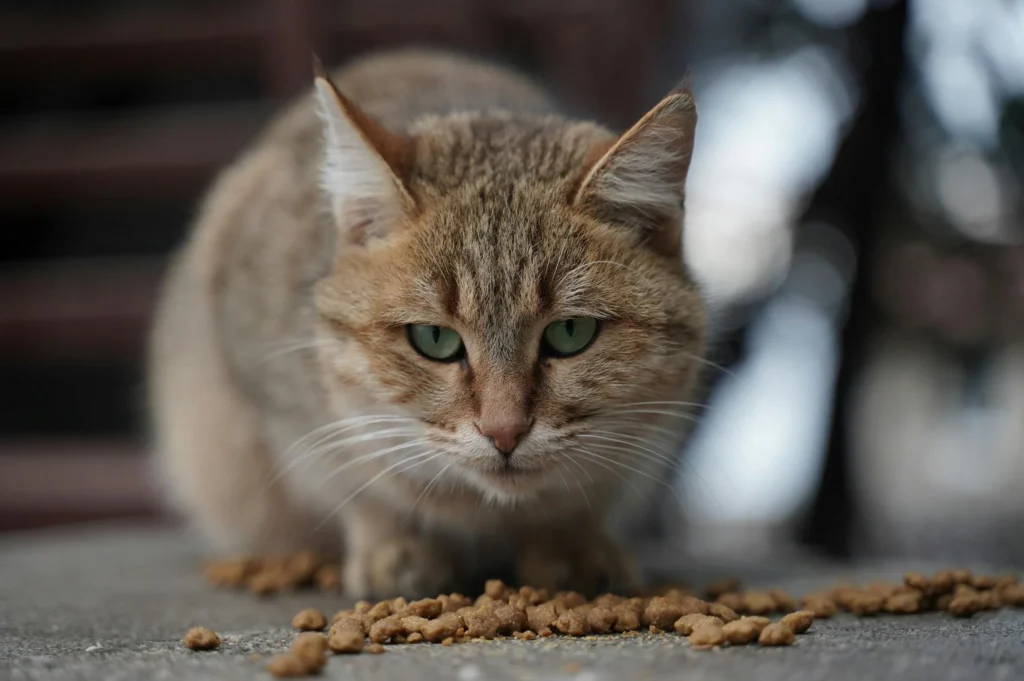
No two cats are the same, and their feeding needs depend on several factors. Here’s a breakdown of what influences how much should I feed my cat:
1. Age 👶🐈⬛
- Kittens: Growing kittens need more calories to fuel their playful antics and rapid development. They typically eat 3–4 small meals a day.
- Adult Cats: Once cats reach adulthood (around 1 year), their calorie needs stabilize, and most do well with 2 meals daily.
- Senior Cats: Older cats (7+ years) may have slower metabolisms or health conditions that require adjusted portions.
2. Weight and Body Condition ⚖️
A cat’s ideal weight depends on their breed, size, and frame. A vet can help you assess your cat’s Body Condition Score (BCS), which ranges from 1 (emaciated) to 9 (obese). A score of 4–5 is ideal for most cats, meaning you can feel their ribs with slight fat coverage and see a defined waistline.
3. Activity Level 🏃♂️
- Active Cats: Cats that zoom around the house or play fetch need more calories.
- Couch Potatoes: Less active or indoor cats require fewer calories to avoid weight gain.
4. Health Conditions 🩺
Cats with conditions like diabetes, hyperthyroidism, or kidney disease may need specialized diets or portion adjustments. Always consult your vet for tailored advice.
5. Spayed/Neutered Status ✂️
Spayed or neutered cats often have lower energy needs due to hormonal changes, so their portions may need to be reduced to prevent weight gain.
6. Type of Food 🥫🍗
- Wet Food: Higher in moisture and often lower in calories per ounce, wet food can be fed in larger portions.
- Dry Food: More calorie-dense, so portions are smaller.
- Raw or Homemade Diets: These require precise measurements to ensure nutritional balance.
By considering these factors, you can better answer the question, “How much should I feed my cat?” and tailor their diet to their unique needs. 😻
Vet-Approved Cat Feeding Chart 📊
To take the guesswork out of how much should I feed my cat, we’ve created a vet-approved feeding chart based on guidelines from trusted veterinary sources, including the American Animal Hospital Association (AAHA) and the Cornell Feline Health Center. These are general recommendations for healthy adult cats—always consult your veterinarian for personalized advice, especially for kittens, seniors, or cats with specific health conditions. 😺
Feeding Chart for Adult Cats (Wet Food, Canned) 🥫
| Weight (lbs) | Daily Amount (oz) | Calories Needed |
|---|---|---|
| 5–6 lbs | 3–4 oz | 150–180 kcal |
| 7–8 lbs | 4–5 oz | 180–240 kcal |
| 9–10 lbs | 5–6 oz | 240–300 kcal |
| 11–12 lbs | 6–7 oz | 300–360 kcal |
| 13–15 lbs | 7–8 oz | 360–450 kcal |
Source: Adapted from AAHA Nutritional Assessment Guidelines for Dogs and Cats (2010) and Cornell Feline Health Center recommendations for feline calorie needs.
Feeding Chart for Adult Cats (Dry Food) 🥣
| Weight (lbs) | Daily Amount (cups) | Calories Needed |
|---|---|---|
| 5–6 lbs | ¼–⅓ cup | 150–180 kcal |
| 7–8 lbs | ⅓–½ cup | 180–240 kcal |
| 9–10 lbs | ½–⅔ cup | 240–300 kcal |
| 11–12 lbs | ⅔–¾ cup | 300–360 kcal |
| 13–15 lbs | ¾–1 cup | 360–450 kcal |
Source: Based on AAHA Nutritional Assessment Guidelines and calorie recommendations from the World Small Animal Veterinary Association (WSAVA) Global Nutrition Committee.
Kitten Feeding Chart (0–12 Months) 🍼
Kittens need more frequent meals and higher calories to support their growth spurts:
- 0–4 weeks: Kitten milk replacer (consult a vet for formula and feeding schedule).
- 4–8 weeks: 1–2 oz wet food or ⅛–¼ cup dry food, 4 times daily.
- 2–6 months: 2–3 oz wet food or ¼–⅓ cup dry food, 3–4 times daily.
- 6–12 months: Transition to adult portions, 2–3 meals daily.
Source: Derived from Cornell Feline Health Center kitten nutrition guidelines and American Veterinary Medical Association (AVMA) recommendations for pediatric feline care.
Notes:
- Wet Food: A standard 5.5 oz can of wet food contains ~150–200 kcal, so adjust portions based on the brand’s calorie content (check the label!).
- Dry Food: Calorie content varies (typically 300–400 kcal per cup), so always refer to the packaging for precise measurements.
- Mixed Feeding: If combining wet and dry food, halve the portions of each to stay within your cat’s daily calorie needs.
Pro Tip from Dr. Sarah Thompson, DVM: “These charts are a great starting point, but every cat is unique. Weigh your cat regularly and adjust portions if you notice weight gain or loss. A quick chat with your vet can fine-tune your feeding plan! 😸”
How Often Should I Feed My Cat? ⏰
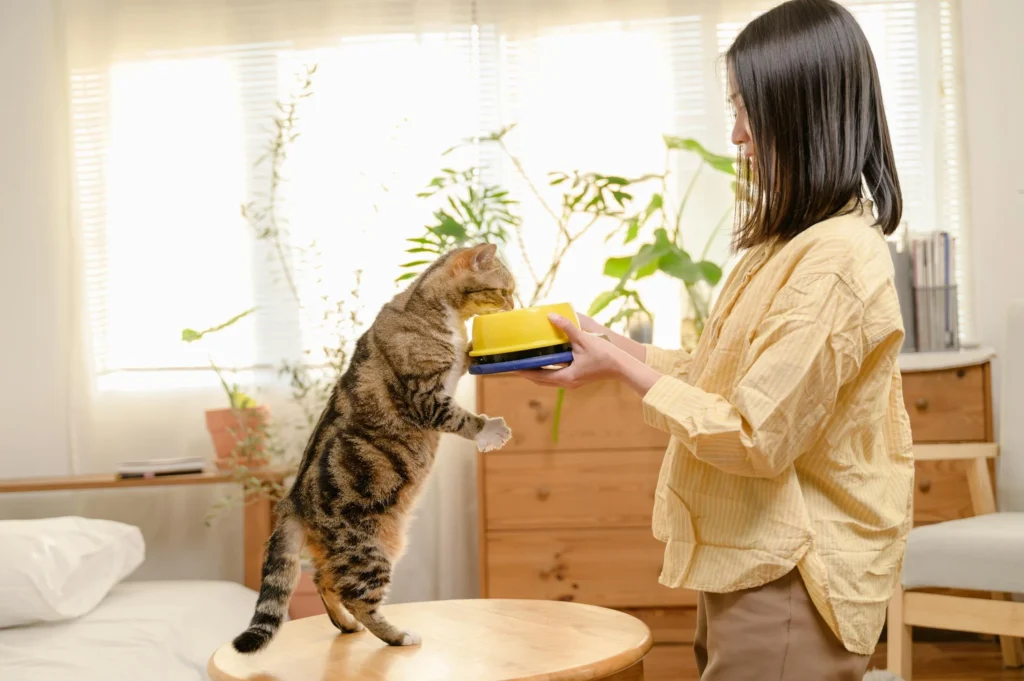
Another common question is, “How often should I feed my cat?” The answer depends on their age, lifestyle, and preferences. Here’s a quick guide:
- Kittens: Feed 3–4 small meals daily to support growth.
- Adult Cats: Most thrive on 2 meals daily (morning and evening). Some prefer smaller, more frequent meals.
- Senior Cats: May benefit from 2–3 smaller meals to aid digestion.
- Free-Feeding: Leaving dry food out all day is convenient but can lead to overeating. Use it only for cats who self-regulate well.
Pro Tip from Dr. Sarah Thompson, DVM: “Cats are natural grazers, so splitting their daily portion into two or three meals mimics their instincts and keeps their metabolism steady. 🕒 If your cat begs between meals, try puzzle feeders to keep them entertained without extra calories.”
Wet Food vs. Dry Food: Which Is Better? 🤔
The debate between wet and dry food is a hot topic among cat parents. Both have pros and cons, and the best choice depends on your cat’s needs and your lifestyle. Here’s a breakdown:
Wet Food 🥫
- Pros:
- High moisture content (70–80%) supports hydration, especially for cats prone to urinary issues.
- Often more palatable for picky eaters.
- Lower in carbohydrates, which aligns with a cat’s natural diet.
- Cons:
- More expensive and less convenient to store.
- Spoils quickly if left out.
- Best For: Cats with urinary tract issues, diabetes, or those who need encouragement to drink water.
Dry Food 🥣
- Pros:
- Convenient and cost-effective.
- Long shelf life and easy to measure.
- Can help maintain dental health (though not a substitute for brushing).
- Cons:
- Lower moisture content (10–12%), which may contribute to dehydration if cats don’t drink enough.
- Higher in carbs, which can lead to weight gain.
- Best For: Cats who self-regulate eating and have no health issues requiring wet food.
Vet Insight: “A combination of wet and dry food can offer the best of both worlds,” says Dr. Emily Rivera, DVM. “For example, feed wet food in the morning and evening for hydration, and leave a small portion of dry food for snacking. Just be sure to adjust portions to avoid overfeeding.” 😺
Pro Tips for Feeding Your Cat Like a Pro 🐾
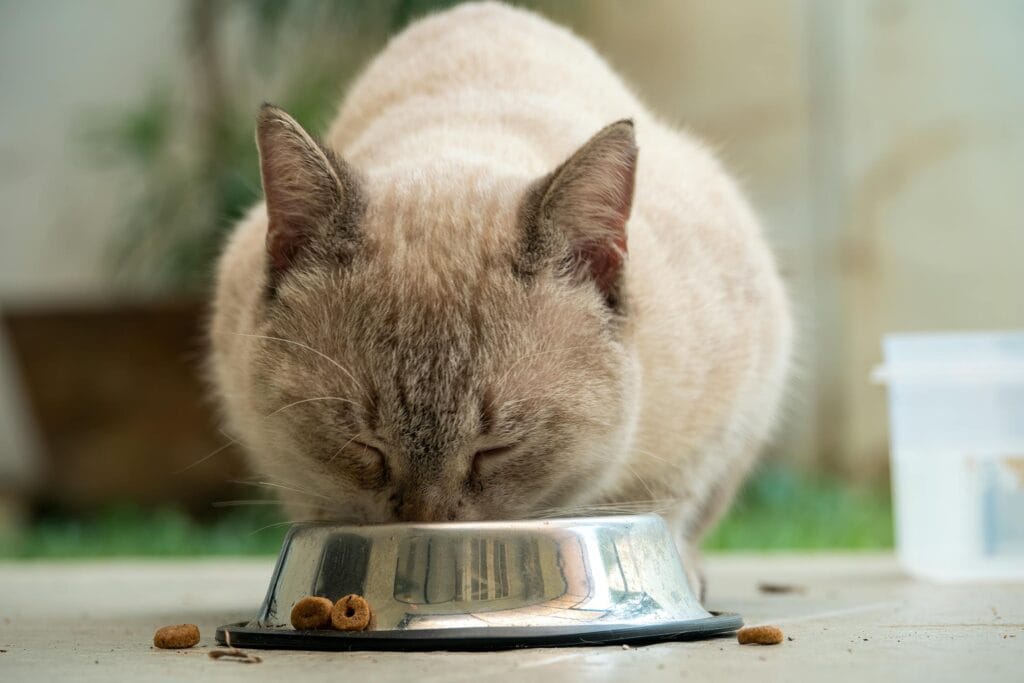
Ready to level up your cat-feeding game? Here are some vet-approved tips to ensure your kitty gets the right nutrition:
- Measure Portions Precisely 📏
Use a measuring cup or kitchen scale to avoid eyeballing portions. Even a small overfeed can add up over time. - Check Food Labels 🏷️
Look for foods labeled “complete and balanced” by the Association of American Feed Control Officials (AAFCO). Check the calorie content to calculate portions accurately. - Transition Foods Gradually 🔄
Switching foods? Mix the new food with the old over 7–10 days to avoid tummy troubles. Start with 25% new food and increase gradually. - Keep Water Fresh 💧
Cats are more likely to drink from clean, flowing water sources. Consider a cat water fountain to encourage hydration. - Use Puzzle Feeders 🧩
For cats who gobble food too quickly or need mental stimulation, puzzle feeders slow eating and make mealtime fun. - Monitor Weight and Behavior 👀
Weigh your cat monthly and watch for signs of over- or underfeeding (e.g., lethargy, excessive begging, or weight changes). Adjust portions as needed. - Avoid Human Foods 🚫
Foods like chocolate, onions, garlic, and grapes are toxic to cats. Stick to cat-safe treats in moderation.
Common Mistakes to Avoid When Feeding Your Cat ❌
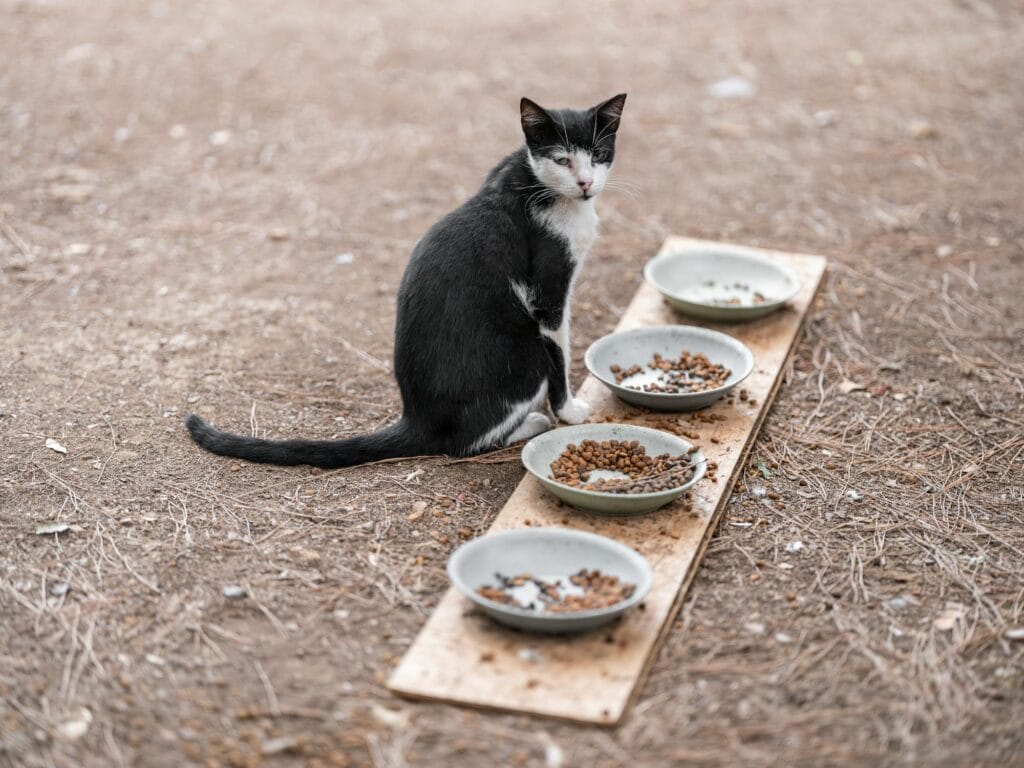
Even well-meaning cat parents can make feeding mistakes. Here’s what to watch out for:
- Overfeeding Treats: Treats should make up no more than 10% of your cat’s daily calories. Too many treats = sneaky weight gain. 😿
- Ignoring Portion Guidelines: Feeding “by feel” often leads to overfeeding. Stick to the feeding chart and adjust based on your cat’s needs.
- Not Consulting a Vet: If your cat has health issues or you’re unsure about their diet, a vet can provide tailored advice.
- Leaving Food Out All Day: Free-feeding can lead to obesity, especially with dry food. Scheduled meals are better for most cats.
- Sudden Diet Changes: Abrupt food switches can cause diarrhea or vomiting. Always transition slowly.
FAQs About How Much Should I Feed My Cat ❓
1. How do I know if I’m feeding my cat too much?
If your cat is gaining weight, has a round belly, or you can’t feel their ribs, they may be overfed. Consult your vet to adjust portions.
2. Can I feed my cat only dry food?
Yes, but ensure they drink enough water to compensate for the low moisture content. Wet food or a mix is often better for hydration.
3. How much should cats be fed if they’re indoor vs. outdoor?
Outdoor cats may need 10–20% more calories due to higher activity levels. Indoor cats typically need less to avoid weight gain.
4. What if my cat is always hungry?
Constant hunger could signal boredom, a medical issue (e.g., hyperthyroidism), or a low-quality diet. Check with your vet to rule out health problems.
5. How often should I feed my cat if they’re on a weight-loss plan?
Feed smaller, more frequent meals (e.g., 3–4 times daily) to keep them satisfied while reducing total calories. Use a vet-recommended diet.
Trustworthy Sources and Veterinary Expertise 📚
This guide is grounded in recommendations from trusted veterinary sources, including:
- American Veterinary Medical Association (AVMA): Guidelines on feline nutrition and obesity prevention.
- American Animal Hospital Association (AAHA): Nutritional assessment guidelines for cats.
- Cornell Feline Health Center: Research on feline dietary needs and kitten nutrition.
- World Small Animal Veterinary Association (WSAVA): Global Nutrition Committee recommendations for feline calorie needs.
- Association of American Feed Control Officials (AAFCO): Standards for complete and balanced cat food.
- Veterinary Input: Insights from Dr. Sarah Thompson, DVM, and Dr. Emily Rivera, DVM, with over 15 years of combined experience in feline care.
By following these expert-backed tips, you’re ensuring your cat’s diet is both nutritious and tailored to their needs. 😺
Conclusion: Feed Your Cat with Confidence! 🐾
Figuring out how much should I feed my cat doesn’t have to be a guessing game. With our vet-approved feeding chart, practical tips, and a deeper understanding of your cat’s unique needs, you’re now equipped to feed your feline friend like a pro. 😸 Whether you’re navigating portion sizes, choosing between wet and dry food, or wondering how often should I feed my cat, the key is consistency, observation, and a sprinkle of love.
Ready to make mealtime a purr-fect experience? Start by measuring your cat’s food, scheduling their meals, and checking in with your vet for personalized advice. Your cat will thank you with head bumps and happy purrs! 🐱💕
Have questions about your cat’s diet? Drop them in the comments below, and let’s keep the conversation going! 😺
